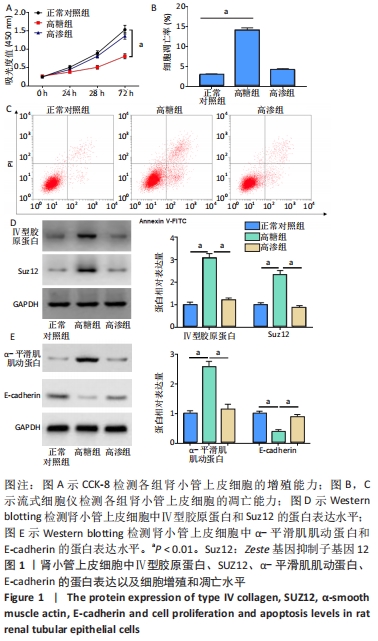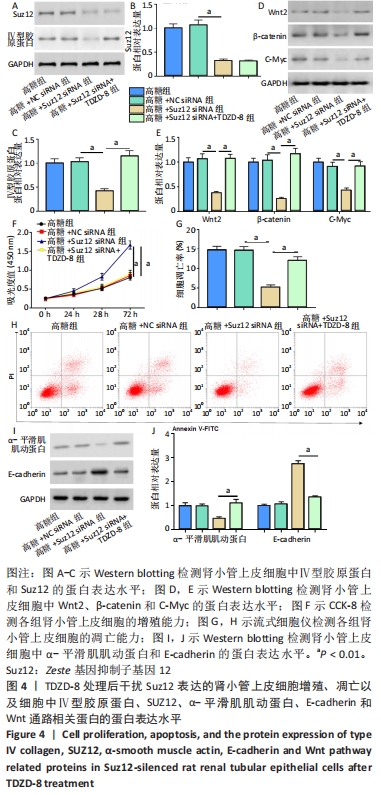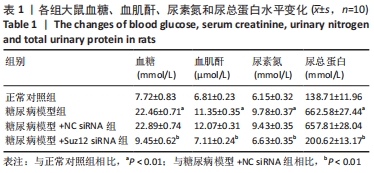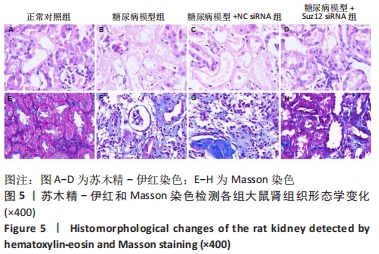中国组织工程研究 ›› 2023, Vol. 27 ›› Issue (8): 1179-1186.doi: 10.12307/2022.1001
• 组织构建实验造模 experimental modeling in tissue construction • 上一篇 下一篇
Zeste基因抑制子基因12在糖尿病肾脏病模型大鼠肾组织中的表达
赵 璐1,赵逸菲2,高 达1,刘艳芳3,付婷婷1,徐江雁4
- 河南中医药大学第三附属医院,1内分泌科,3肾病科,河南省郑州市 450008;2河南中医药大学龙子湖校区,河南省郑州市 450046;4河南中医药大学,河南省郑州市 450046
Expression of suppressor of Zeste 12 in kidney tissues of rats with diabetic nephropathy
Zhao Lu1, Zhao Yifei2, Gao Da1, Liu Yanfang3, Fu Tingting1, Xu Jiangyan4
- 1Department of Endocrinology, 3Department of Nephrology, the Third Affiliated Hospital of Henan University of Chinese Medicine, Zhengzhou 450008, Henan Province, China; 2Longzi Hu Campus, Henan University of Chinese Medicine, Zhengzhou 450046, Henan Province, China; 4Henan University of Chinese Medicine, Zhengzhou 450046, Henan Province, China
摘要:

文题释义:
糖尿病肾脏病:是由糖尿病引起的肾脏疾病,属于糖尿病最严重的微血管并发症之一,已成为世界终末期肾脏病的第2位原因,仅次于肾小球肾炎。肾小管间质纤维化是导致糖尿病终末期肾功能衰竭的主要原因之一。
SUZ12:是Polycomb 抑制复合物 2(PRC2)的核心蛋白,是一种组蛋白甲基化转移酶,指导组蛋白3赖氨酸 27 (H3K27Me3)的甲基化和基因沉默。研究表明,SUZ12 蛋白在包括肾癌在内的多种肿瘤中过度表达,促进肿瘤细胞迁移、侵袭以及上皮间质转化。其中,上皮细胞-间充质细胞转化是导致糖尿病肾脏病肾脏纤维化发生的机制之一,因此SUZ12可能在糖尿病肾脏病的发展过程中起着至关重要的作用。
背景:Zeste基因抑制子基因12(Suppressor of zeste gene 12,Suz12)可参与肾小管上皮细胞的上皮间质转化。
目的:探讨Suz12对糖尿病肾脏病进程的影响及其相关作用机制。
方法:①细胞实验:将大鼠肾小管上皮细胞分为正常对照组(葡萄糖5.5 mmol/L)、高糖组(葡萄糖30 mmol/L)和高渗组(葡萄糖5.5 mmol/L+甘露醇24.5 mmol/L);将100 nmol/L Suz12小干扰RNA(siRNA)及其阴性对照(NC siRNA)转染至高糖培养的肾小管上皮细胞中后48 h,采用Western blotting、CCK-8和流式细胞仪检测Suz12、Ⅳ型胶原蛋白、α-平滑肌肌动蛋白和E-cadherin的蛋白表达、细胞增殖和凋亡。采用染色质免疫共沉淀检测Suz12和金属蛋白酶组织抑制因子3的结合;金属蛋白酶组织抑制因子3表达抑制与组蛋白H3K27me水平增加有关,以甲基化特异性PCR法检测金属蛋白酶组织抑制因子3组蛋白H3K27me3甲基化水平;采用Wnt/β-catenin通路激活剂TDZD-8(10 μmol/L,1 h)处理转染Suz12 siRNA的肾小管上皮细胞,以验证Wnt通路的激活是否影响干扰Suz12对细胞损伤的作用。②动物实验:采用腹腔注射60 mg/kg链脲佐菌素构建糖尿病大鼠模型,并通过尾静脉注射0.1 mL含3×108 PFU空腺病毒载体(NC siRNA)或Suz12 siRNA腺病毒(Suz12 siRNA)的PBS;实验结束后收集血清、尿液和肾脏组织,采用全自动生化分析仪检测血糖、血肌酐、尿氮素、尿总蛋白水平;苏木精-伊红和Masson 染色观察肾脏组织形态学变化;Western blotting检测肾脏组织中相关蛋白的表达水平。
结果与结论:①与正常对照组相比,高糖组肾小管上皮细胞中Suz12、Ⅳ型胶原蛋白和α-平滑肌肌动蛋白蛋白表达水平明显升高,E-cadherin蛋白表达水平明显降低,细胞增殖减少,凋亡率增加;而转染Suz12 siRNA可逆转高糖处理对肾小管上皮细胞的损伤;②与高糖+Suz12 siRNA组相比,TDZD-8处理可逆转Suz12敲低对肾小管上皮细胞中Ⅳ型胶原蛋白、α-平滑肌肌动蛋白、E-cadherin和Wnt通路相关蛋白表达水平、细胞增殖和凋亡的影响;③Suz12可与金属蛋白酶组织抑制因子3结合,显示金属蛋白酶组织抑制因子3存在H3K27me3修饰,且敲低Suz12可降低高糖诱导的肾小管上皮细胞中金属蛋白酶组织抑制因子3甲基化水平;④与糖尿病组相比,Suz12 siRNA组大鼠血糖、血肌酐、尿氮素、尿总蛋白水平明显降低,肾脏组织病理变化和纤维增生得到缓解,Ⅳ型胶原蛋白、Suz12和Wnt通路相关蛋白表达水平显著降低,E-cadherin表达水平明显升高;⑤结果表明,Suz12在糖尿病大鼠中可能通过促进金属蛋白酶组织抑制因子3甲基化参与糖尿病肾脏病发展。
缩略语:Zeste基因抑制子基因12:Suppressor of zeste gene 12,Suz12;金属蛋白酶组织抑制因子3:tissue inhibitor of metalloproteinases-3,TIMP3
https://orcid.org/0000-0002-4505-6361 (赵璐)
中国组织工程研究杂志出版内容重点:组织构建;骨细胞;软骨细胞;细胞培养;成纤维细胞;血管内皮细胞;骨质疏松;组织工程
中图分类号:







